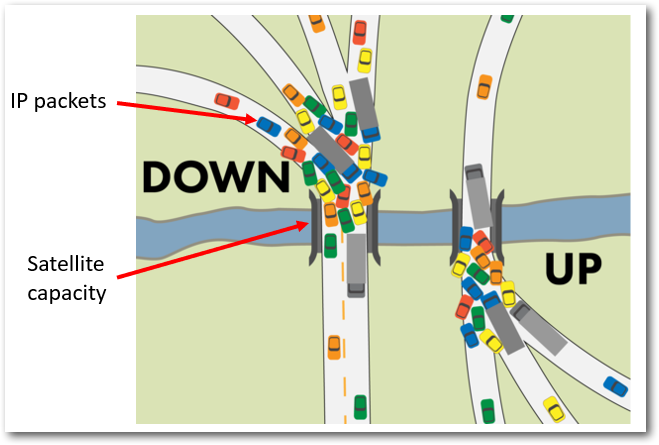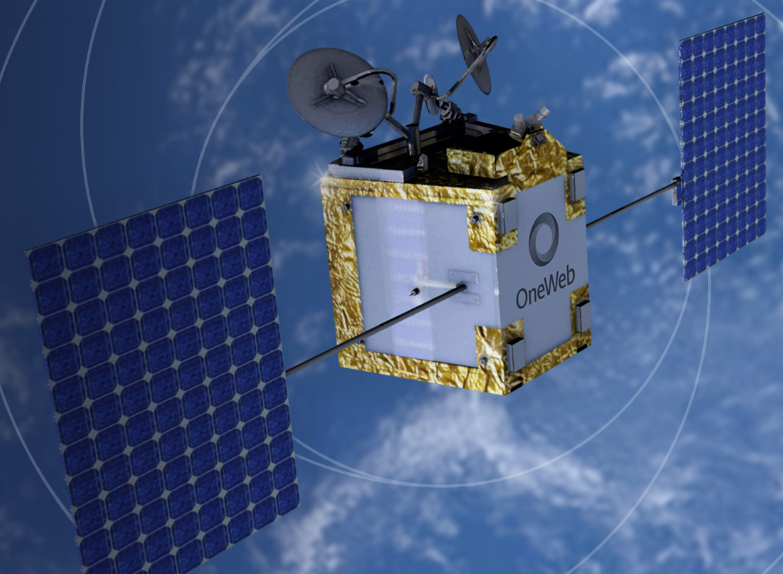
In yesterday’s post focussing on Sure Falkland Island’s public presentation, I talked about some observations asserted by the presenter about their technical views of Starlink. Although I am far from being a technical expert in satellite technology. It is a fact that Starlink is the highest capacity system in existence today.
Here are my ‘expert’ technical views (with help from others!) about Starlink and OneWeb satellite capacities and how they compare. I felt that I needed to talk about these ‘technical’ assertions in greater depth. I do hope that what I have written is reasonable as it’s been posted to the 4,800 satellite guys in the MegaConstellations group on LinkedIn. I warn you, this could get quite technical!
To remind you, some of these comments which don’t tell the whole story were :
“Stanley has one Starlink beam above it and that beam has a maximum capacity of 750Mbit/s”
“Starlink uses ‘beam technology’ like all LEO services and Starlink’s beam is the size of Stanley”
“1st version of Starlink has only 750Mbit/s of capacity available to a town the size of Stanley”
“Starlink has stopped accepting new customers in London due to congestion”
“If all Stanley switched to Starlink then speeds would reduce below 10Mbps”.
“This is not very different from what Sure has today.“
“We will publish a paper by an ‘indpendent satellite experts assessment'”

Starlink satellite capacity capabilities.
Starlink operates using phased array antennas and high-frequency spectrum bands (Ku-band (12–18 GHz) and Ka-band (26.5–40 GHz).), which allows for flexible allocation of bandwidth to different geographical areas based on demand. In regions with higher utilization – say, dense urban areas or regions with higher subscriber density. It can do this because it employs electronically steerable phased-array antennas on both the satellite and user terminal sides.
Starlink can dynamically allocate more of its available spectrum to serve that demand efficiently. Starlink can dynamically allocate bandwidth and steer beams with high flexibility, allowing them to:
- Concentrate more bandwidth over high-demand areas.
- Reuse frequencies across different beams.
- Combine beams from multiple satellites (multi-satellite aggregation).
For example, if a typical Starlink cell utilizes 250MHz of spectral bandwidth, it might deliver approximately 1Gbps per cell under ideal conditions. However, in higher-demand areas, Starlink can allocate double the spectral bandwidth of 500MHz to a single cell, effectively doubling the throughput potential. This doubling is achieved by transmitting vertical and horizontal polarised signals on the same frequency. Sky does the same.
The system can accommodate more simultaneous users and higher per-user data rates with more bandwidth. Using standard spectral efficiency assumptions (which depend on modulation schemes, signal quality, etc.), 500MHz of bandwidth can deliver up to 2Gbps per cell.
But Starlink doesn’t stop there.
Because Starlink satellites use beamforming and are in low Earth orbit (LEO), multiple satellites can cover the same geographic area and hand off traffic between them. By coordinating two satellites to serve the same cell area and aggregating their capacity, you can combine their throughput.
- Each satellite, providing 500MHz of bandwidth, contributes up to 2Gbps.
- However, due to overhead, interference management, and some non-linearities, the combined throughput typically isn’t a perfect 4Gbps (2Gbps + 2Gbps). Instead, practical deployment and coordination reduce the combined gain slightly.
A reasonable estimate would be around 3Gbps aggregated throughput per cell when combining two satellites. This is especially powerful in areas with high peak demand (such as Stanley), allowing Starlink to dynamically balance load and improve the user experience without adding additional infrastructure on the ground.
Moreover, Starlink has laser-based Inter Satellite Links (ISLs), allowing satellites to communicate directly and efficiently coordinate traffic and hand-offs. This makes multi-satellite aggregation practical, especially in areas with high satellite density overhead. It also means very low latencies as the speed of light is so much higher in space compared to terrestrial paths.
 It was also stated as an implied negative that “Starlink has stopped accepting new customers in London due to congestion“. Specific figures for the number of active Starlink terminals in London have not been publicly disclosed. However, as of December 2024, Starlink had approximately 87,000 users across the UK. The suspension of new service packages in Greater London and parts of Southeast England suggests that the existing infrastructure has reached its current capacity limits. This is a favourable situation, not a negative one, as it shows that Starlink is actively monitoring and managing congestion to maintain a minimum level of Quality of Service.
It was also stated as an implied negative that “Starlink has stopped accepting new customers in London due to congestion“. Specific figures for the number of active Starlink terminals in London have not been publicly disclosed. However, as of December 2024, Starlink had approximately 87,000 users across the UK. The suspension of new service packages in Greater London and parts of Southeast England suggests that the existing infrastructure has reached its current capacity limits. This is a favourable situation, not a negative one, as it shows that Starlink is actively monitoring and managing congestion to maintain a minimum level of Quality of Service.
Existing users have reported that, during large downloads, speeds can drop to approximately 50Mbps after an initial period of higher performance. Starlink’s Standard plan now advertises download speeds between 25–100Mbps, while the Priority plan offers 40–220Mbps. Starlink download speeds globally can be seen here.
Empirically, it is rumoured that there are now 500+ Starlink terminals active in the Falkland Islands, and no severe service degradation has been reported to date.

What about OneWeb?
 OneWeb primarily uses the Ku-band, focusing on 12.75-14.5 GHz uplink and 10.7-12.75 GHz downlink. OneWeb has a beam bandwidth of around 250 MHz to 500 MHz.
OneWeb primarily uses the Ku-band, focusing on 12.75-14.5 GHz uplink and 10.7-12.75 GHz downlink. OneWeb has a beam bandwidth of around 250 MHz to 500 MHz.
It uses mechanically steered parabolic antennas for user terminals (though this is changing as new terminals evolve).
Beamforming and flexibility are more hub-and-spoke oriented, with traffic routed through fixed gateway ground stations, unlike Starlink’s inter-satellite links (ISLs) architecture.
OneWeb’s design is less dynamic in its ability to reallocate spectrum on the fly compared to Starlink. It lacks the same level of flexibility in dynamic bandwidth scaling per area as available in Starlink.
OneWeb currently does not have ISLs. All data traffic routes through ground gateways. For aggregation, OneWeb relies on ground-based network coordination, which introduces latency and bottlenecks, making real-time aggregation across multiple satellites less efficient or feasible.
Combining two satellites to serve the same cell and aggregate their capacity (like Starlink’s 3Gbps per cell strategy) is not something OneWeb can easily do. Hence, the OneWeb service is only offered to Camp and business customers in Stanley, leaving most Falkland Islands’ consumers without a high-speed Internet access service.
| OneWeb Gen 1 | Starlink (V1.5) | |
|---|---|---|
| Max Throughput/Satellite | ~8-10 Gbps | ~20 Gbps (some sources say 17-23 Gbps) |
| Beams | ~16 beams | 64-100+ beams (phased array beams) |
| ISLs | No | Yes (laser links) |
| Spectrum Flexibility | Medium (Ku-band focused) | High (Ku + Ka-band, dynamic) |
In practice, OneWeb has zero flexibility in capacity/bandwidth allocation. There are 250MHz of spectrum allocated to each spot beam, and the spot beams come in a fixed pattern. Nothing can be done to improve download speeds in regions of higher utilization.
What is the size of the cells? Because of the lower orbit height of 55km, Starlink’s cells are 20 to 50km in diameter, while OneWeb’s higher orbit of 1,200km has cell sizes of 150 to 400km. Starlink is then well suited to high density of user regions, while OneWeb is more focused on mobility, business and rural areas.

Conclusions
The comments made by Sure Falkland Islands in the presentation did not tell the whole story and presented a poor prognosis of Starlink usage in the Falkland Islands. We would encourage Sure Falkland Islands to publish their expert’s paper so it can analyzed.
To reiterate, OneWeb cannot easily match Starlink’s ability to dynamically double spectral bandwidth allocation to high-utilization areas and aggregate capacity from multiple satellites seamlessly in real time. This is largely due to:
- Lack of inter-satellite links.
- Fixed ground-based gateways.
- Less flexible antenna technology (though improvements may be coming).
That said, OneWeb can still allocate more bandwidth per beam in high-demand areas within its system limits, but not to the same degree of scalability or efficiency as Starlink.
OneWeb definitely has a role to play in the Falklands, but not as a Starlink replacement.

For the (very) highly technical-minded.
-
Single Beam Case – Nco=1:
- Normally, at a specific frequency, only one beam from a satellite covers a specific area (called a “user cell”) on the ground.
- This beam uses either right-hand circular polarization (RHCP) or left-hand circular polarization (LHCP) to avoid interference.
- That one beam delivers full signal strength (maximum power).
-
Two Beams Covering Same Area – Nco=2:
- Alternatively, two beams can cover the same area at the same frequency, one with RHCP and one with LHCP.
- But to avoid overwhelming the area with too much signal (violating regulatory limits called PFD – Power Flux Density), each beam has to lower its power by 3 dB (cutting the power in half).
- This lower power reduces the signal-to-noise ratio (SNR) of each beam.
The technical calculation of beam download data rate is determined by Shannon’s law i.e. In information theory, the Shannon–Hartley theorem tells the maximum rate at which information can be transmitted over a communications channel of a specified bandwidth in the presence of noise.
The technical calculations are as follows (I believe!).
-
With one beam (normal case):
- SNR = 9 dB → translates to an SNR power ratio of 7.94.
- Using Shannon’s formula, the max theoretical capacity is:
- 250 MHz × log₂(1 + 7.94) ≈ 790 Mbps
-
With two beams (each reduced by 3 dB):
- SNR = 6 dB per beam → SNR power ratio 3.98.
- Each beam delivers about 579 Mbps, and there are two beams:
- 579 Mbps + 579 Mbps ≈ 1158 Mbps total
-
Comparing:
- 1158 Mbps / 790 Mbps ≈ 1.47x increase (~50% more capacity), not double (100%) as you might intuitively expect.

Chris Gare, OpenFalklands March 2025, copyright OpenFalklands

One Reply to “Starlink in the Falklands – March 2025 – Sure’s views on Starlink in high density regions”